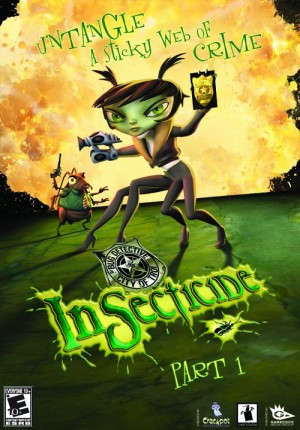Mike Levine & Larry Ahern interview - page 2
"People still talk about these games for the same reason we got excited making them: they’re fully realized interactive worlds."
At LucasArts they worked on games ranging from the original Sam & Max all the way to The Curse of Monkey Island. Now Mike Levine and Larry Ahern run their own company, Crackpot Entertainment, and they're putting the final touches on their debut title Insecticide, a film noir-inspired action-adventure set in a world populated by bugs.
We had a chance to ask Levine and Ahern some questions about their new project as well as their past work. We discuss the hybrid nature of Insecticide's gameplay, the role of humor in many successful adventure games, what went wrong with the ending in The Curse of Monkey Island, and much more. Also, find out which other LucasArts (and Sierra!) veterans worked on Insecticide...
First of all, not everyone might know all the games you worked on, so please tell us about your game industry backgrounds.
ML (Mike Levine): We invented Pong. Ok, that's a lie. We aren't that old.
LA (Larry Ahern): We did play Pong though.
ML: Actually, I preferred "Blip" over Pong.
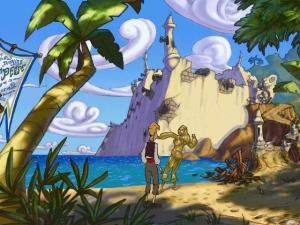 |
The Curse of Monkey Island |
LA: I worked at LucasArts from 1990-2000, where I played neither Blip nor Pong (although we had a Centipede and Asteroids machine that I was quite fond of). It was actually LucasFilm Games when Mike and I both started there. Then I spent another 6 years at Microsoft Games Studios until leaving to form Crackpot.
ML: And I worked at LucasArts from 1991 through 1997, and have done other interactive projects with my company, Pileated Pictures.
 |
Larry Ahern |
LA: But, I’m guessing our LucasArts tenure is probably of more interest to your readers than any of our other projects, like my work as a bounty hunter, or Mike’s stint in the circus. And, besides having a natural talent for bounty hunting, I’ve always been artistic, so that got my foot in the door at LucasArts. I started out doing background layouts on the first incarnation of The Dig, then stumbled into animation on Monkey Island II: LeChuck's Revenge where I collaborated a lot with Tim Schafer and Dave Grossman.
We were on the same wavelength, I think, and I ended up as lead animator on Day of the Tentacle, also designing the characters and coming up with visual gags. After that, I did some animation and character designs on Sam & Max: Hit the Road, then helped Tim develop Full Throttle, serving again as lead animator. Until I was given the reins to… Monkey Island, which was a challenge, but also a thrill. I worked with Jonathan Ackley as co-designer/writer/project leader/art director/car detailer on The Curse of Monkey Island, managing an amazingly talented team of animators, artists, writers, musicians, and other people I’ve already offended even before the end of the sentence by not mentioning them.
After that, I spent a few years developing some epic games that never got published, and working on some smaller titles until moving on to a job with Microsoft. Microsoft was good to me in a lot of ways, but things just never really clicked creatively for me there. Which, of course, left me highly susceptible to... Crackpot ideas.
 |
Mike Levine |
ML: My stay at LucasArts often found me working under the radar doing all kinds of art-techie, art path stuff in the art department. Mainly before we made the jump to full 3D there was all kinds of 2D stuff I brought in to LucasArts as I was into all these new digital video tools like After Effects and Premiere.
I was the art technician on Sam & Max: Hit The Road (the "acoustic" version, as I now call it), I created the art path and did a lot of 2DFX on The Dig, and I worked with Larry on those games, as well as working closely on Full Throttle and The Curse of Monkey Island editing the opening and other big cinematic sequences together.
I did a lot of the R&D work at Lucas for all things video -- from Rebel Assault to the Dark Forces series. Looking back on it I can at least say our team created the first digitally made light sabers, ever (woo-hoo!), and the stuff we did shooting entirely on the bluescreen was really years ahead of its time if you look at the state of filmmaking today.
Even though most LucasArts adventure games are now over ten years old, people still talk about them all the time. Why do you think that is? And does it ever seem strange to you?
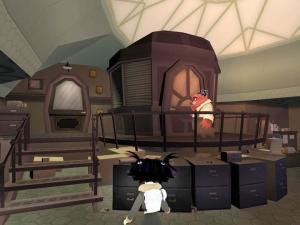 |
Insecticide |
ML: It was strange to me when I first realized it. I didn't think anyone remembered those games when I moved back to the east coast. I was speaking at a college and mentioned I worked on those games and students started cheering. I was like, what, you kids were 10 when those came out?! But those games had great, dare I say, classic characters and stories (something sorely missing from games today), and those are the things that stick with you. As much as the "gameplay zealots" and techies in this industry want you to believe it’s all about the gameplay, that’s usually not what lasts with people over time.
LA: I think people still talk about these games for the same reason we got excited making them: they’re fully realized interactive worlds. Yes, game mechanics and technology have changed and evolved over time, but if those storylines and interactivity were developed enough and logically interwoven, it works and should hold up. Plus, we were hitting some of the first generation of kids to grow up with games. I’d like to think we made some classic stuff, but some people are just really nostalgic for things from their childhood…even total crap. Why do we love He-Man and Scooby-Doo, and why do we need an old Dukes of Hazzard lunchbox, if we never pack a lunch? I don’t know… it’s just a fun snapshot of where we were back then, like that favorite 1980’s photo of you in the skinny tie and mullet.
ML: You're dissing Scooby Doo?!
You guys have been working on the ideas for Insecticide for quite a few years, haven't you? Can you give us a picture of how those ideas evolve, how you convince publishers they're the right ideas, and how you eventually end up with a concept that can enter production?
ML: To be honest, I don't know that I have all the answers to that. We just knew how to (and we had time to) flesh out the story and characters into what we think is a believable world. "Put some meat on the bone," as I often have said. That, plus drive and determination to show it to people who, if you have something good, will usually respond. But yes, we’ve been working on Insecticide for well over 4 years. I had this idea about a young bug girl and her sidekick which got things rolling. I was inspired by the dynamic relationship of the lead characters in the film The Professional while at the same time was watching shows like The Wire a lot, and being inspired by films like Sin City. Then Larry, Peter Chan, Dave Grossman (who worked with us in the beginning), and I started to really flesh it out from there. Dave really brought out a lot of the classic Film Noir aspects and schooled us all in that.
You've described Insecticide as half action, half adventure. Did you give each gameplay style their own segments in the game, or did you blend them together throughout?
LA: At first glance, it may not sound as cool to say we separated the two, but the realities of blending them together just doesn't make a lot of sense when you sit down to work out the details. In a well paced detective film or cop show there are manic sections and more subdued ones. If you want to have any control over flow and the feel of it, you kind of have to put certain "walls" up to keep the player in the basic situation you want. If you blend them, you lose focus. So, they’re separate, but the length of each and where they are placed in the structure of the entire story makes sense for what’s happening, the info we want to give the player, and the pacing we’re trying to establish.
 |
 |
Screenshots from the PC version of Insecticide
Can you describe the adventure elements in more detail? Specifically what types of puzzles or challenges can we expect, and what sort of elements of discovery and exploration did you incorporate into the design?
LA: First of all, the game’s detective mode is pure adventure gameplay. We’ve got inventory objects, items there and in the environment can be examined and combined, there are interactive dialog trees, and the whole thing is a series of puzzles created out of the goals presented by the storyline. So, I think it has all the richness of the good old games, with lots of hidden things to explore and funny stuff to uncover if you click on it all. We worked on these sections with a fantastic writer named Josh Mandel, who you may remember as a writer/designer at Sierra on classics like Space Quest 6: Roger Wilco in the Spinal Frontier and Freddy Pharkas: Frontier Pharmacist.
ML: But, these detective sections won’t have mind-numbingly complex puzzles. One reason for that is we wanted the game to be accessible and not require a hint book every 5 minutes. Another reason is we wanted better control over the pacing. We felt that combining the action and adventure genres wouldn’t work if the adventure sections were so massive and complex that the whole thing ground to a halt as you wandered the world collecting inventory for days at a time. So, the puzzle sections have twists and turns and will take some creative thinking, but they all exist within smaller, self-contained environments, meaning they’re solvable in a reasonable amount of time to keep things rolling along. This is an epic game, after all, and there’s a lot to see. The kiss of death in an adventure game is a puzzle no one can get past and get stuck on. Move along people!
Will a novice gamer be able to handle the action gameplay in Insecticide?
ML: We really think so. There is auto-targeting on the DS and it really helps. And, we certainly tested it out on plenty of young kids as well as older, non-action gamers. We are definitely aiming for a balanced experience with Insecticide. Plus, if our old thumbs can get through it, we think most will!
This is a somewhat obscure question, so please bear with me. I'm reminded of an old Curse of Monkey Island interview in which it was asked why Guybrush Threepwood lost his cutlass early in the game. It
was said that a cutlass would be a far too useful item to have in many of the puzzle situations. In Insecticide your character presumably carry weapons that could be used in powerful ways, so does that ever undermine certain puzzle ideas you come up with?
LA: Yeah, I think there were a lot of characters in those old games that we had to disarm so as not to mess up all the puzzles! And Guybrush is one of those lawless pirate types that would probably want to stab everyone he could, just for fun, so it was especially necessary with him. With Insecticide, we mostly designed our way around that issue. A lot of the detective mode scenarios put Chrys in situations where pulling out a gun and shooting something or someone is just wildly inappropriate and out of character. And then, without giving too much away, there are later sections where other circumstances prevent her from using her weapons at all.
Plus, the old adventure games were mostly frustrating if you were playing a heavily-armed commando type, but just ran around collecting inventory and unlocking doors, and never got to shoot anything. Since Chrys gets to use her weapons a lot in the action levels, we didn’t feel like having players holster them while investigating clues or interrogating suspects was asking too much.
When the adventure genre comes up in mainstream gaming forums or publications, it's often the funny ones that get mentioned first. How important is humor in adventure games?
LA: Well, I know there are a lot of beloved serious adventure games out there, but I think the comedy is pretty critical. And that’s mostly because it covers a major flaw in the interactive structure, namely, that branching dialog trees just aren’t very good conversation simulators. If the game plays it straight, I find the dialog trees can get tedious; I just want to race through them and get to the info. But, when it’s a comedy, the simulation isn’t any better, but it’s a lot more entertaining because each wrong dialog choice can still lead to a separate punch line.
I just think there’s a better payoff for the player if it’s a comedy. For example, right now I’m in the middle of writing response lines for miscellaneous objects you can examine in the levels. And I have two rules: the response either has to be funny, or it has to tell the player something important about the characters/world (and should also be funny). In a serious adventure title, the stuff you examine is either going to be dull, because you can’t have that much stuff with embedded meaning (“Oh, it’s my favorite pencil from when I was a child!”), or there just won’t be that much stuff to click on. So, in conclusion, comedy = more value for your gaming dollar.
Read on as we discuss the challenges of designing The Curse of Monkey Island...
The next two questions are specifically for Larry. Recently many developers have been extending old and much-loved franchises that they didn't originally conceive (Fallout 3 and BioShock come to mind.) I think you were one of the first people to take on a problem like that with The Curse of Monkey Island. Did you want to create a game with your own signature (like a spiritual successor), or did you want it to seamlessly blend in with the first two Monkey Island games? Was it possible to please old fans while also introducing a new spin?
LA: You know, I thought it was a great situation for designing my first game (well, co-designing, with Jonathan). Because, on the one hand, we were getting to work on a fun franchise that was still so rich with potential, and on the other hand, it had been so long since the previous installment, and production values had improved so much, that it felt like we could put our own spin on it.
I know there are some vocal fans that will say the art changes I implemented “ruined” Monkey Island, but I’m pretty sure they’re in the minority. I’d like to think. I hope (you’re not putting my contact info on this article, are you?). The way I saw it, the characters in the first two games were so small and low-res anyway, that we had some freedom to reinterpret them a bit while adding more pixels. Also, I wanted the visual style to hint at the comical nature of the IP a little more than it had in the previous two. Of course, I was the guy who did a bunch of animations on Monkey Island 2 where I kept trying to squeeze in an anvil dropping on Guybrush’s head (Ron never went for it), so I have been known to get carried away.
Monkey Island 2 had a notoriously bizarre ending, which Monkey Island 3 mostly ignored until the very end. It then explained every detail in a lengthy grand finale dialog sequence. How difficult was it to work with the complexities of the existing Monkey Island plot? And was it always the plan to explain everything in the final dialog sequence?
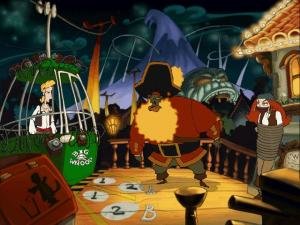 |
The infamous Curse of Monkey Island end scene. |
LA: Well, I guess I can say this, since I have no responsibility to the sales of the product anymore, but… I think one of our failures was not working the elements of that explanation, and LeChuck himself, in better over the course of the game. And, I mean interactively, not just through cutscenes. Our other goof was the big finale cutscene that we trimmed down to nothing because we were paranoid about staying on schedule and budget.
But, we wrote the lengthy LeChuck chat, since we didn’t know where Ron was going with the ending to Monkey Island 2, and were afraid that our brilliant explanation would focus too much attention on off-themed locations. We had other swashbuckling things in mind, and didn’t want to put players back at Big Whoop amusement park too much (and we really didn’t want it at the beginning… gotta start out as piratey as possible).
So, it was a struggle between the yin of explaining Monkey Island 2, and the yang of telling our different pirate story. And the yuck…the yuck, I guess, of screwing them both up. Kind of a yin/yang/yuck thing. Thankfully, Curse of Monkey Island was a comedy, so we could just make fun LeChuck’s tedious exposition, pepper it with jokes, and call it a day.
How does your design approach with Insecticide compare to games you've created in the past?
LA: Insecticide was fun, because I felt like it was the first opportunity to blend elements of everything we’d been doing recently with everything we liked and were good at from the old days (back when we had to walk 10 miles in the snow just to get to a computer, and we made art with pixels as big as your head). So, a lot of the detective levels are pretty rich environments with characters and props that all have some depth and story to them. But, we’re combining that with 3rd person action, so there’s an interesting balance. Even though the two styles are separated, I think they inform each other.
The games you worked on at LucasArts were painted and animated in 2D. Most games today are rendered in 3D -- even A Vampyre Story by Autumn Moon Studios uses 3D characters. In your opinion, is complete 2D still a viable style for computer games? Would you perhaps have done Insecticide in 2D if it were a DS exclusive?
ML: Tons of casual games are still made in 2D. And there have been a handful of 2D adventure titles on the DS, so it still can be done. But the real question is, can you really give a "AAA" or close to it experience with pure 2D? I honestly think the only way to do it is to still use 3D to make a 2D look. Any 2D film like the Triplets of Belleville does this, and we all know games that do it as well. But in the world of Web and Flash based games, which my other companies Pileated Pictures and Planet Cazmo are still firmly entrenched in, there are plenty of pure 2D games. But, even this will eventually change, I think. 3D just gives too much flexibility.
LA: I think it depends on what you’re trying to accomplish. For a long time the issue was more about style; you could accomplish such a variety of unique looks in 2D that weren’t possible in 3D because the technical limitations seemed to impose a certain sameness to it. But that’s improving. Meanwhile, the big bonus with 3D is the ability to add textural detail and lighting to the characters, as well as reusing animations from different angles. You can save a lot of work just by not having to redo animations from multiple camera angles.
But, at the end of the day, I think it comes down to what look you want. There are ways to get a unique style in 3D, and there are tricks for keeping production work to a minimum in 2D. As for Insecticide on the DS, we never considered full 2D, but did toy with pre-rendering 3D backgrounds to give us higher visual quality. But, at the end of the day, we wanted the immersiveness of full real-time 3D, and we think it was the right choice.
What differences are there between the PC and DS versions of Insecticide in terms of graphics or gameplay?
ML: The DS has much reduced poly count and texture limit. The gameplay is fairly similar as the levels and stories follow each other.
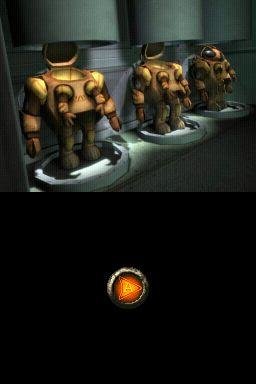 |
Insecticide DS |
LA: Yeah, we’ve been saying they’re the same game, which they essentially are, but there will be some minor differences. Obviously, there are some variations with the interface, but the mouse and the stylus both allow us to give them a similar flavor, which is great. And, the PC version will have some additional level of detail, both in terms of visuals, items to interact with, and some extended content in the cutscenes. And, the PC is delivered in two separate chapters, whereas the DS is all on one cart, so some things were adjusted to fit the experience of each version.
Have you used ScummVM to play any of the games you worked on in the past? If so, what is your opinion of the ScummVM project?
ML: I’ve used it a little and I think the whole thing is amazing. I don't keep up with it on a regular basis, but I heard they had it working on the DS too? I really want to check that out.
LA: I haven’t used it, but I definitely want to set up the old games on my DS. I’ve been telling my son about it, since he’s never played any of them (and he pretty much stole my DS once we finished production on Insecticide). So, now I’m going to force him to play some old skool games.
It's great to see so many studios staffed by LucasArts veterans creating new games, like Autumn Moon, Double Fine, Telltale Games and your own company Crackpot Entertainment. Will all of you ever form some kind of awesome alliance?
ML: We already have one. We meet once a year on the eclipse wearing dark hooded robes in a foggy field. I can't talk more about what happens after that, and your readers likely wouldn't want to read it. In all seriousness, we are friends with all of those guys and wish them the best on their projects!
LA: What are you talking about, Mike?! What about that whole East Coast vs. West Coast gang rivalry thing you’ve been going on about? Bad blood? Take no prisoners? Last time we rumbled with Telltale, Mike and Dan Connors met in an alley behind the GameStop, respective studios in tow. They stared each other down, strapped one hand together, armed themselves with controllers in the other, and had a game battle to the tune of Beat It. There was a lot of moonwalking, and I played a wicked guitar solo. Or something like that. My memory’s a little hazy.
What are your hopes and dreams for Crackpot Entertainment going forward? More action-adventures? Episodic gaming?
LA: My dream is to create that perfect game that makes an audience cry. I really feel the elusive formula is probably just a combination of the right inventory items, a double-jump, and maybe a power-up when you least expect it. Next thing you know, you feel a catch in your throat and we gotcha! I’ve misted up a few times with Insecticide, but I just don’t think we have enough polygons yet to really get anybody sobbing. We looked into getting the Terms of Endearment license, but Shirley McLean’s holding out for a MMORPG deal, so we scrapped that plan.
ML: Actually, we want to keep making original stuff -- that is our primary objective. We will always want to make games with great worlds, characters, and stories. As I have said, we are IP [Intellectual Property] driven, but I think we will always want to play with pace and ways to convey story in games, and that is tough if its a 100% action game. Thanks again for this interview and (blatant sell pitch coming!) we hope people pre-order Insecticide DS!



